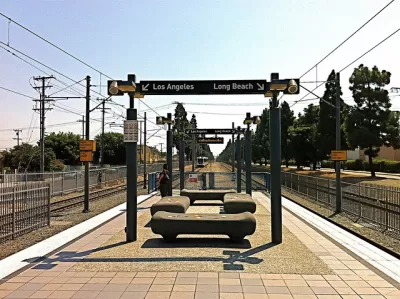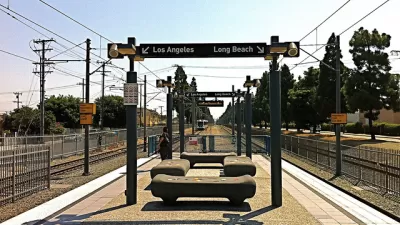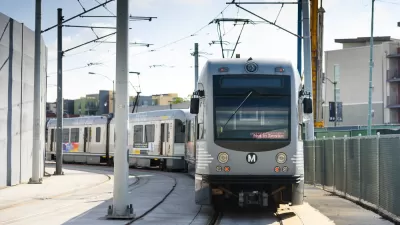Over a century ago, the Pacific Electric Railway operated a line between downtown Los Angeles and Long Beach that competed its journey ten minutes faster than LA Metro's Blue Line does. What gives?

Back in 1916, Brian Addison writes, "the Pacific Electric Railway's Long Beach line, which stretched directly from Downtown Los Angeles to Downtown Long Beach, was nearly ten minutes faster than the current line."
Slow rail transit is arguably better than no rail transit, a deprivation Los Angeles suffered for several decades after the demise of its early 20th century rail transit system. But as Addison points out, "the Long Beach stretch of [the Blue Line] is the only stretch that doesn't have a signal preemption or synchronization system—that is, controllers for the movement of traffic that gives preference to Metro trains rather than street traffic."
That means trains slow to a snail's crawl as they navigate traffic signals, getting bogged down with automobile traffic.
Thankfully, the Los Angeles County Metropolitan Transportation Authority is on the case: the line is currently undergoing rehabilitation to address the issue and will fully reopen on November 2. "Workers have been fine-tuning the systems attached to create priority for the train to save time for commuters," Addison writes. Still, time savings will likely not exceed the ten-minute mark.
FULL STORY: Opinion: C’mon, Metro—the LA-to-LB rail line was quicker a century ago than it is now

Study: Maui’s Plan to Convert Vacation Rentals to Long-Term Housing Could Cause Nearly $1 Billion Economic Loss
The plan would reduce visitor accommodation by 25,% resulting in 1,900 jobs lost.

North Texas Transit Leaders Tout Benefits of TOD for Growing Region
At a summit focused on transit-oriented development, policymakers discussed how North Texas’ expanded light rail system can serve as a tool for economic growth.

Why Should We Subsidize Public Transportation?
Many public transit agencies face financial stress due to rising costs, declining fare revenue, and declining subsidies. Transit advocates must provide a strong business case for increasing public transit funding.

How Community Science Connects People, Parks, and Biodiversity
Community science engages people of all backgrounds in documenting local biodiversity, strengthening connections to nature, and contributing to global efforts like the City Nature Challenge to build a more inclusive and resilient future.

Alabama: Trump Terminates Settlements for Black Communities Harmed By Raw Sewage
Trump deemed the landmark civil rights agreement “illegal DEI and environmental justice policy.”

Dear Tesla Driver: “It’s not You, It’s Him.”
Amidst a booming bumper sticker industry, one writer offers solace to those asking, “Does this car make me look fascist?”
Urban Design for Planners 1: Software Tools
This six-course series explores essential urban design concepts using open source software and equips planners with the tools they need to participate fully in the urban design process.
Planning for Universal Design
Learn the tools for implementing Universal Design in planning regulations.
City of Santa Clarita
Ascent Environmental
Institute for Housing and Urban Development Studies (IHS)
City of Grandview
Harvard GSD Executive Education
Toledo-Lucas County Plan Commissions
Salt Lake City
NYU Wagner Graduate School of Public Service





























